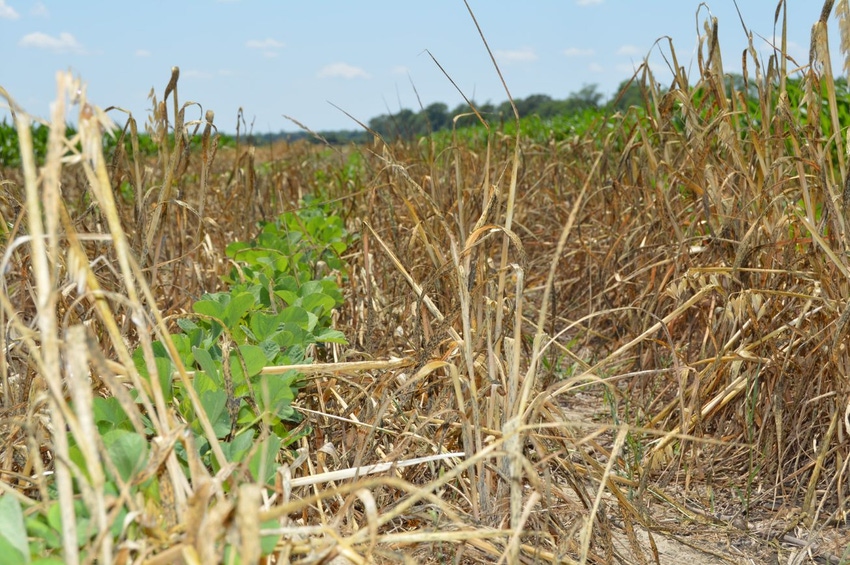
Producers interested in planting cover crops this fall should select species based on what they expect to achieve.
Options for erosion control, for instance, vary from those that improve soil structure, scavenge and cycle soil nutrients, alleviate hardpans or increase organic matter.
“Having a clear objective for planting a cover crop aids in cover crop management,” says Josh Copes, LSU Ag Center, Saint Joseph, La. “If minimizing soil erosion is the main objective, a cereal cover crop would be a good choice,” he reports in a monthly Louisiana Crops Newsletter.
Copes explains that the fibrous root systems of cereal winter cover crops help prevent topsoil erosion and are good nutrient scavengers. “A tap-rooted cover crop like forage or tillage radish (woolypod vetch, red clover, etc.) is better suited for deep nutrient scavenging and may aid in loosening or preventing a soil compaction layer.”
Some producers have multiple objectives for winter cover and find species mixes better suited to meet their goals.
“Mixes of cereal and legume covers can reduce early season nitrogen fixation issues in corn,” Copes says. “Preliminary data collected by AgCenter scientists have shown legume cover crops can supply nitrogen for soybeans for early growth needs until nodules develop.”
Cash crop
Producers also need to consider the cash crop to follow the cover, which may affect termination timing of the cover crop.
Copes says, as is the case for cash crops, seed quality for cover crops makes a difference.
“Be sure to plant only quality seed; this will help eliminate weed seed contamination issues. With legumes, make sure the rhizobium inoculant strain is correct for the legume species that will be planted, and always inoculate. If planting pre-inoculated legume seed, get pure live seed per pound and adjust seeding rates accordingly.”
Check seed size. “Some pre-inoculated seed is larger with less pure live seed per pound,” Copes says. Cover crop seeding rates will depend on the seeding method, date of sowing and whether the land is enrolled in a CSP or EQIP program.
“For cereals, avoid low seeding rates and establishment methods that could lead to spotty emergence, which could cause the cereal to bunch (a single plant with multiple tillers and large root system), and lead to main crop establishment issues such as skips and variations with seed placement depth and seedling emergence.”
Best time to plant cover crops, Copes says, depends on date of the main crop harvest. Plant cover crops as soon after harvest as possible, he adds.
“When planted earlier in the fall, growth and biomass production will be maximized before cold weather can slow the growth and development of the cover crop.”
Early planting is especially important if corn will follow. “Early cover crop termination, when planting corn, combined with late planting of a cover crop (November), will reduce overall biomass production, minimizing the benefits of the cover crop,” Copes explains. “Legumes are generally slow-growing if planted too late (November), and biomass production will be minimal before cold weather occurs.”
NRCS Regulations
Producers should consider special circumstances on land enrolled in an NRCS conservation program that requires cover crops. “Be sure to follow the NRCS cover crop guidelines,” Copes says. NRCS seeding rates and planting dates for common cover crops grown in Louisiana can be found at https://bit.ly/2k1YaTk.
The planting window for most winter cover crops is Oct. 1 to mid-November. Ranges for average first frost dates for Monroe, Shreveport, Alexandria and Baton Rouge are Nov. 15, 18, 19, and 29, respectively.
Copes recommends producers check the AgCenter website for useful tools to accomplish the intended cover crop goals for a farm. The website includes: Potential scenarios and implications for incentives payments (https://bit.ly/2lxZPR9) and a Q&A on Conservation policy and crop insurance (https://bit.ly/2k59HkU).
“NRCS payments for cover crops change from year to year,” Copes says. “Updated numbers are included in the Cover crop decision tool (https://bit.ly/2lFQiHr) in estimating overall costs of cover crops implementation.”
A key consideration, Copes says, is setting a goal for the cover crop, taking into consideration what crop will follow the cover and determining expectations.
About the Author(s)
You May Also Like






